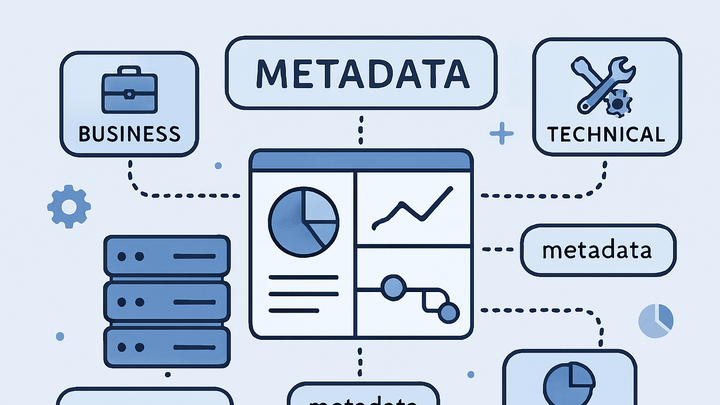Published on 2025-06-28T04:55:34Z
What Is Metadata Management? Examples and Best Practices
Metadata Management in analytics refers to the systematic process of capturing, organizing, storing, and governing metadata—the data about your data. It ensures that everyone in your organization can discover, understand, and trust the data they work with. By maintaining a centralized metadata repository, teams can track data lineage, enforce data governance policies, and improve analytics accuracy. Leading SaaS tools like PlainSignal and Google Analytics 4 (GA4) support metadata tagging through custom attributes and dimensions, making it easier to classify and contextualize events. Effective metadata management reduces errors, speeds up analysis, and helps maintain compliance with data privacy regulations.
Metadata management
Organizing, governing, and cataloging metadata to improve data discovery, compliance, and analytics accuracy.
Why Metadata Management Matters in Analytics
Implementing metadata management unlocks the hidden value of your analytics data by providing context and structure. It helps teams quickly find relevant datasets, ensures consistent usage of metrics across reports, and strengthens data governance.
-
Improved data discoverability
Metadata tags and catalogs allow analysts to search and locate datasets or events by keywords, descriptions, or categories rather than guessing table names or event IDs.
-
Enhanced data governance
By attaching ownership, classification, and usage policies to data assets, organizations can enforce compliance with internal standards and external regulations like GDPR or CCPA.
-
Better analytics accuracy
Consistent definitions and standardized metadata reduce discrepancies in metrics (e.g., defining a “session” or “conversion”) across teams and dashboards.
Core Components of Metadata Management
A robust metadata management framework relies on several foundational elements, from capturing diverse metadata types to maintaining a centralized repository and tracking data lineage.
-
Metadata types
Different categories of metadata capture unique aspects of your data assets and their usage.
-
Business metadata
Human-readable descriptions, data definitions, and SLAs that explain what a dataset or event represents in business terms.
-
Technical metadata
Schema details, field types, table sizes, update frequencies, and technical dependencies within your data infrastructure.
-
Operational metadata
System logs, data quality statistics, load times, and pipeline performance metrics.
-
-
Metadata repository
A centralized catalog or database where all metadata is stored, searched, and managed. It acts as the single source of truth for data definitions and lineage.
-
Metadata lineage
Visualization and tracking of how data flows and transforms from origin to final report, helping identify upstream dependencies and troubleshoot errors.
Implementing Metadata Management with SaaS Tools
Modern analytics platforms offer built-in or extensible metadata features. Here’s how to leverage PlainSignal and GA4 for effective metadata management.
-
PlainSignal integration
PlainSignal provides a lightweight, cookie-free analytics setup. You can attach metadata through custom attributes directly in your tracking snippet. Example setup:
<link rel="preconnect" href="//eu.plainsignal.com/" crossorigin /> <script defer data-do="yourwebsitedomain.com" data-id="0GQV1xmtzQQ" data-api="//eu.plainsignal.com" src="//cdn.plainsignal.com/plainsignal-min.js"></script>Using the
data-doattribute, you can namespace events or pages for better classification. -
GA4 implementation
Google Analytics 4 supports custom dimensions and user properties to capture rich metadata alongside events.
-
Defining custom dimensions
In the GA4 admin settings, create new custom dimensions (e.g.,
page_category) and map them to event parameters. -
Mapping metadata to events
When sending events via
gtag.jsor Tag Manager, include the metadata parameter:gtag('event', 'page_view', { page_category: 'blog', author: 'Jane Doe' });
-
Best Practices for Metadata Management
Adopting best practices ensures your metadata remains accurate, consistent, and valuable as your data ecosystem grows.
-
Standardize naming conventions
Use clear, consistent names and avoid ambiguous abbreviations. Document naming rules in your metadata repository.
-
Automate metadata collection
Leverage APIs, data pipelines, and SDKs to capture technical and operational metadata without manual effort.
-
Regular audits and governance
Schedule periodic reviews to update stale metadata, resolve conflicts, and retire unused entries.
Common Challenges and Solutions
Even with a solid plan, metadata management can hit roadblocks. Recognizing these challenges early helps you mitigate them effectively.
-
Metadata silos
Different teams storing metadata in separate tools. Solution: Consolidate catalogs and enforce centralized governance.
-
Data drift and outdated metadata
As schemas evolve, metadata can become inaccurate. Solution: Automate lineage tracking and integrate schema-change alerts.
-
Scalability issues
Large datasets and high event volumes can overload metadata stores. Solution: Implement archiving strategies and partitioning.
